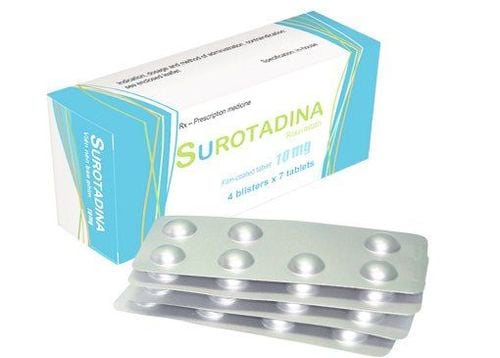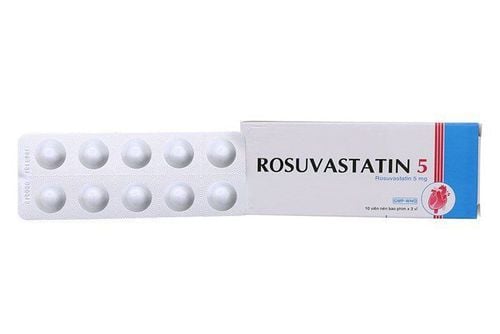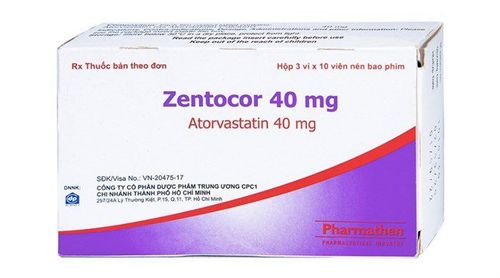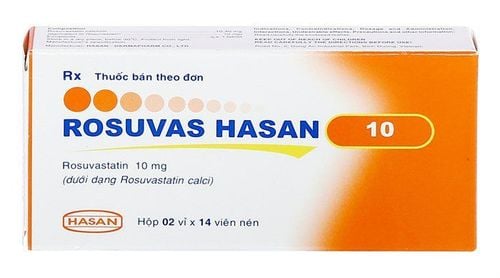This is an automatically translated article.
Simvahexal is a drug that works to treat lipid metabolism disorders, with the effect of inhibiting the production of cholesterol precursors. This drug is often prescribed along with diet and exercise to help reduce blood fat and limit the risk of complications caused by hyperlipidemia.
1. What are the effects of Simvahexal?
The drug Simvahexal 10 has the main ingredient Simvastatin 10 mg, which is made in the form of film-coated tablets. Simvastatin is a synthetic lipid-lowering drug belonging to the statin class. Simvastatin is an inactive lactone, after oral administration, it is hydrolyzed to the corresponding beta-hydroxyacid form, which inhibits the reductase 3-hydroxy-3-methylglutayl-Coenzyme A (HMG-CoA). This enzyme catalyzes the conversion of HMG-CoA to mevalonate (a precursor of cholesterol).
From there, the drug reduces cholesterol production and also works to reduce LDL, increase HDL to help reduce cardiovascular events such as myocardial infarction, coronary heart disease
2. Indications and contraindications of the drug Simvahexal
Indications:
Simvahexal 10 is indicated for use in the following cases:
Treatment of primary hypercholesterolemia or mixed dyslipidemia. The drug is used as an adjunct to diet, when the body's response to diet and other non-pharmacological treatments has not been satisfactory. Treatment of homozygous familial hypercholesterolemia as an adjunct to diet and other lipid-lowering measures, such as LDL screening, or when these measures are not appropriate. Treatment of hypertriglyceridemia. Prevention of cardiovascular events and mortality in patients with atherosclerotic cardiovascular disease or diabetes, at normal or elevated cholesterol levels. Contraindications:
Simvahexal is contraindicated in the following cases:
Patients with hypersensitivity to Simvastatin or any component of the drug. Active liver disease or unexplained persistently elevated serum transaminases. Pregnant and lactating women.
3. Dosage and method of drug Simvahexal
How to use: Simvahexal is taken orally, do not break the tablet before taking it, but take it whole, usually a single dose in the evening.
Dosage: Take a single dose of 5 - 80mg/day in the evening. Dosage of the drug is adjusted according to each subject.
The 80 mg dose is only recommended in patients with severe hypercholesterolemia and at high risk for cardiovascular complications, who have not reached the therapeutic goal on lower doses and when the expected benefit outweighs the risk. potential mechanism of the drug. Hypercholesterolemia: The usual starting dose is 10-20 mg/day. Patients who require a drastic reduction in LDL-C levels (> 45%) can be started at 20-40 mg/day. Adjust dosage up or down, if necessary. Homozygous Familial Hypercholesterolemia: Administer at the recommended starting dose of 40 mg/day in the evening. In patients receiving lomitapid concomitantly with simvastatin, the dose of simvastatin should not exceed 40 mg/day. Cardiovascular prevention: The usual dose of simvastatin is 20-40 mg/day, administered as a single evening dose in patients at high risk for coronary heart disease. Patients with renal impairment:
No dose adjustment is required in patients with moderate renal impairment. For patients with severe renal impairment (creatinine clearance <30 ml/min), doses >10 mg/day should be carefully considered. Note:
Simvastatin is effective when used alone or also in combination with drugs that bind bile acids. Should be taken more than 2 hours before or 4 hours after taking drugs that bind to bile acids. In patients receiving simvastatin concomitantly with fibrates, other than gemfibrozil or fenofibrate, the dose of simvastatin should not exceed 10 mg/day. In patients receiving concomitant medications amiodarone, amlodipine, verapamil, diltiazem, the dose of simvastatin should not exceed 20 mg/day. Elderly: No dose adjustment is required.
Children: Use as directed, with a dose range not to exceed 40mg/day.
4. Undesirable effects of the drug Simvahexal
When using Simvahexal you may also experience the following undesirable effects:
Uncommon side effects: headache; digestive problems such as abdominal pain, bloating, indigestion or diarrhea. Rare: Anemia; paresthesia, dizziness; peripheral neuropathy; Pancreatitis; Jaundice hepatitis; rash, itching, hair loss; Myopathy (including myositis), myositis with or without renal failure, myalgia, muscle cramps; Asthenia; angioedema, lupus-like syndrome, dermatitis, vasculitis, thrombocytopenia, eosinophilia, increased erythrocyte sedimentation rate, arthritis and arthralgia, urticaria; sensitivity to light, flushing; shortness of breath and discomfort; increased liver enzymes. Very rare: Insomnia; Memory loss; Fatal and nonfatal liver failure; Some other side effects of unknown frequency: Depression ; Lung disease; Immune-mediated necrotizing myopathy, sometimes complicated by tendon rupture; Erectile dysfunction. When experiencing side effects of the drug, you need to stop using the drug and notify your doctor or you can go to the nearest medical facility for timely treatment.
5. What should be paid attention to when taking Simvahexal?
Before use, tell your doctor about your history of allergies and medical conditions. Patients should have liver enzymes tested before starting statin therapy and in cases of clinical indications need to be tested afterwards for monitoring during drug use. Before treatment, it is necessary to test CK enzymes in the following cases: Decreased kidney function, hypothyroidism, personal or family history of hereditary muscle disease, history of muscle diseases caused by statin use or previous fibrates, heavy alcohol consumption, and elderly patients (>70 years of age) as these are at increased risk for severe muscle disease when taking the drug. If the CK test result is > 5 times the upper limit of normal, statin therapy should not be initiated. Before and during treatment with statins, a combination of diet, weight-loss measures, exercise, and treatment of diseases that may be the cause of the hyperlipidemia should be combined. Lipid-lowering agents may be discontinued or discontinued in any patient presenting with acute and severe myopathy or with predisposing factors for acute renal failure due to rhabdomyolysis, such as severe acute infection, hypotension. Hypertension, major trauma, trauma... Elderly patients: Because elderly patients can often have impaired renal function, special care should be taken, and renal function should be assessed before starting treatment with simvastatin. and henceforth in this age group.
6. Drug interactions
Simvahexal may interact with the following drugs:
Strong cytochrome P450 3A4 inhibitors such as itraconazole, ketoconazole, erythromycin, clarithromycin, HV-protease inhibitors, boceprevir, telaprevir, posaconazole, nefazodone, gemfibrozil, cyclosporin, danazol) increases the risk of myopathy and rhabdomyolysis by increasing HMG-CoA reductase inhibitory activity during treatment with simvastatin. Amiodarone, verapamil and danazol: The risk of myopathy and rhabdomyolysis is increased with concomitant use of amiodarone, verapamil or danazol if high doses of simvastatin are used. Amlodipine and fusidic acid: also increase the risk of myopathy. Rifampicin, Cyclosporin, gemfibrozil. Coumarin Anticoagulants: Bleeding and prolongation of prothrombin time have also been reported in patients receiving simvastatin. Grapefruit or grapefruit juice may increase plasma concentrations of simvastatin. Avoid taking large amounts of grapefruit juice (> 1 liter/day). Medicines to treat HIV and hepatitis C virus (HCV): Increases the risk of muscle damage, the most serious can be rhabdomyolysis, kidney failure leading to kidney failure and the risk of death. . In addition to the drugs mentioned above, other drugs can also cause interactions when used concurrently. Patients should inform their doctor about other medications they are taking so that the doctor can consider and prescribe the right medicine.
Store Simvahexal in an airtight container in a dry place. Storage temperature should not exceed 30°C. Keep medicine out of reach of children.
Simvahexal is prescribed for the long-term treatment of people with dyslipidemia who have not responded to a regular diet. During the course of treatment, the patient should be monitored and examined to detect abnormalities.
Follow Vinmec International General Hospital website to get more health, nutrition and beauty information to protect the health of yourself and your loved ones in your family.













